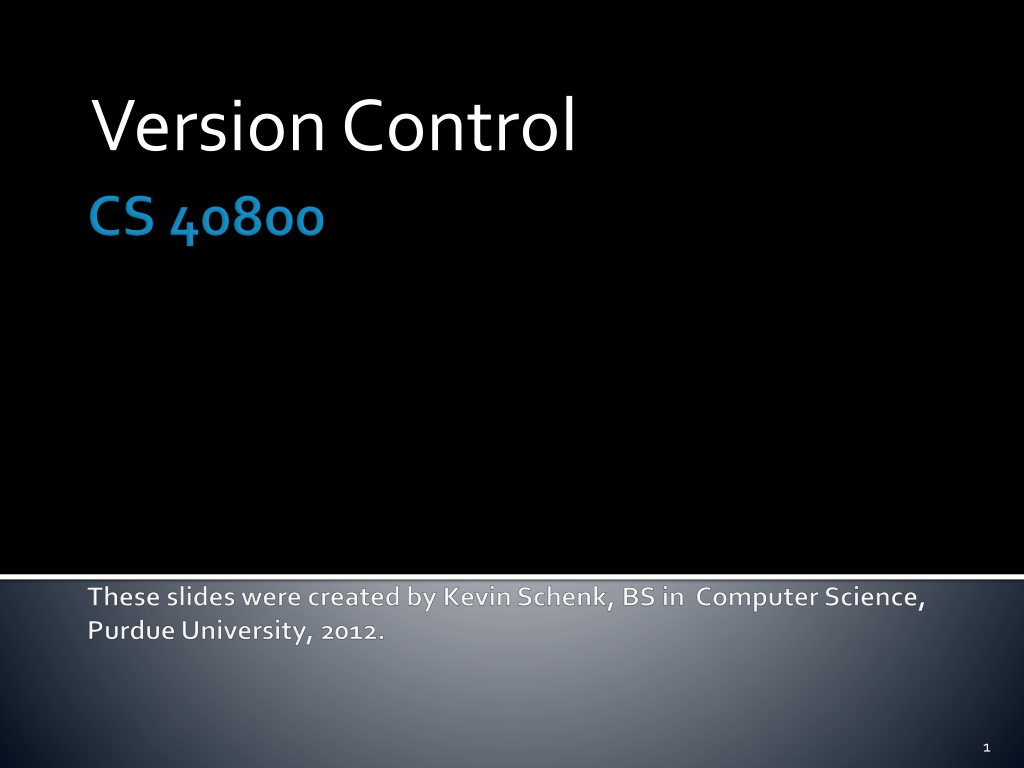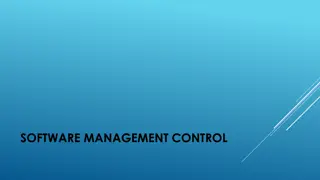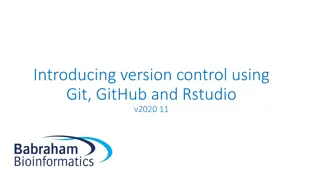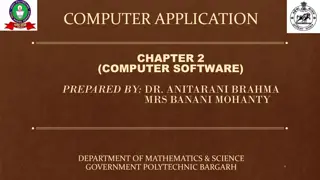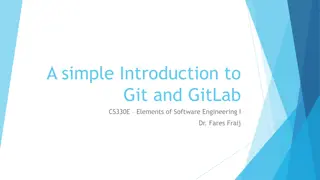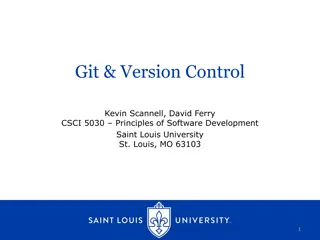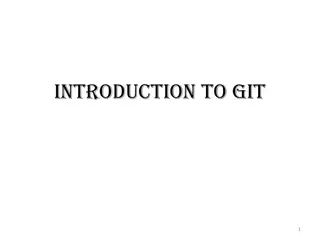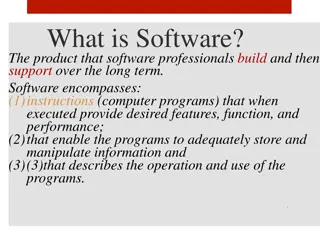Understanding Version Control in Software Development
Version control (or revision control) is essential for managing source files and tracking changes made by teams during development. It allows for reversion to stable code versions, change tracking, branch management, and merging. Learn about commit actions, trunk development lines, and using Subversion commands for effective repository management.
Download Presentation

Please find below an Image/Link to download the presentation.
The content on the website is provided AS IS for your information and personal use only. It may not be sold, licensed, or shared on other websites without obtaining consent from the author. Download presentation by click this link. If you encounter any issues during the download, it is possible that the publisher has removed the file from their server.
E N D
Presentation Transcript
Version control (or revision control) is the term for the management of source files, and all of the intermediate stages as development proceeds. A version control system is a repository of files. Every change made to the source is tracked, along with who made the change, etc. Other items can be kept in a version control system in addition to source files -- Project Charter, Product Backlog, Test Plan, Inspection log, Testing log, . 2
Version control allows us to: Keep everything of importance in one place Manage changes made by the team Track changes in the code and other items Avoid conflicting changes 4
Reversion: If you make a change, and discover it is not viable, how can you revert to a code version that is known to be good? Change/Bug Tracking: You know that your code has changed; but do you know who did it, when, and why? Sometimes this is where a bug was introduced? Branches: How to introduce a completely new feature or concept and not mess up the working code? Merging branches: If I divided the code, how to merge new code with good old code and not mess up 5
Commit: the action of writing or merging the changes made in the working copy back to the repository Trunk: The unique line of development that is not a branch (sometimes called the baseline or mainline) Head: The most recent commit Main Trunk Apple Apple Orange Apple Orange Banana Apple Orange Strawberry Revision 1 Revision 2 Revision 3 Revision 4 (HEAD) 6
To add the file to the repository: svn add list.txt To check-in (commit) the file: svn ci list.txt m Changed the list The -m flag is the message to use for this check-in. Note: Subversion (svn) commands are described in http://www.yolinux.com/TUTORIALS/Subversion.html 7
Main Trunk Apple Orange Banana Check Out Apple Orange Strawberry Revision 3 Revision 4 Apple Orange Strawberry Working Copy Revert Check In (Commit) 8
To get the latest version: svn checkout list.txt To throw away changes: svn revert list.txt To check out a particular version: svn checkout r2 list.txt 9
A set of files under version control may be branched (or forked) at a point in time so that, from that time forward, two (or more!) copies of a file may develop in different ways independently of each other. Apple Grape Apple Grape Cherry Revision 5 Revision 6 Branch Main Trunk Apple Grape Apple Grape Kiwi In SVN: svn copy /path/to/trunk /path/to/branch Revision 4 Revision 7 10
Apple Grape Apple Grape Cherry +Cherry Revision 5 Revision 6 Branch Main Trunk Apple Grape Apple Grape Kiwi Apple Grape Kiwi Cherry +Kiwi +Cherry Revision 4 Revision 7 Revision 8 In SVN: svn merge r6:7 /path/to/branch 11
A conflict occurs when different parties make changes to the same document, and the system is unable to reconcile the changes. A user must resolve the conflict by combining or manually editing the changes. Apple Grape Cherry Check In Revision 4* (Bob) Apple Grape Apple Grape Cherry Main Trunk Revision 4 Revision 5 Apple Kiwi Check In Conflict Revision 4* (Alice) 12
Each team must use some version control system. You must use a repository which requires authentication. This is so that no other team can gain access to your repository. In addition to turning in documents on BlackBoard, teams will also commit their documents and code to their repository Give your Project Coordinator access to view your repository 13
GitHub is a web-based hosting service for software development projects that use the Git revision control system GitHub <https://github.com> GitHub offers free accounts for open source projects 14
GitHub Documentation <https://help.github.com> GitHub is the most popular open source code repository site We suggest you use GitHub to gain experience with it Employers, startups, and hackathons increasingly use Github 15
Bitbucket is a web-based hosting service for projects that use either the Git or Mercurial revision control systems Bitbucket <https://bitbucket.org> Bitbucket Free Academic Accounts <http://blog.bitbucket.org/2012/08/20/bitbucket- academic> Bitbucket Documentation <https://confluence.atlassian.com/display/BITBUCKET/ Bitbucket+Documentation+Home> 16
Subversion (SVN) - http://subversion.apache.org TortoiseSVN (Windows) - http://tortoisesvn.tigris.org Concurrent Version Systems (CVS) - http://savannah.nongnu.org/projects/cvs Git - http://git-scm.com GitHub (Mac & Windows) http://www.github.com TortoiseGit (Windows) - http://code.google.com/p/tortoisegit Mercurial - http://mercurial.selenic.com RabbitVCS (Linux) - http://www.rabbitvcs.org 17
